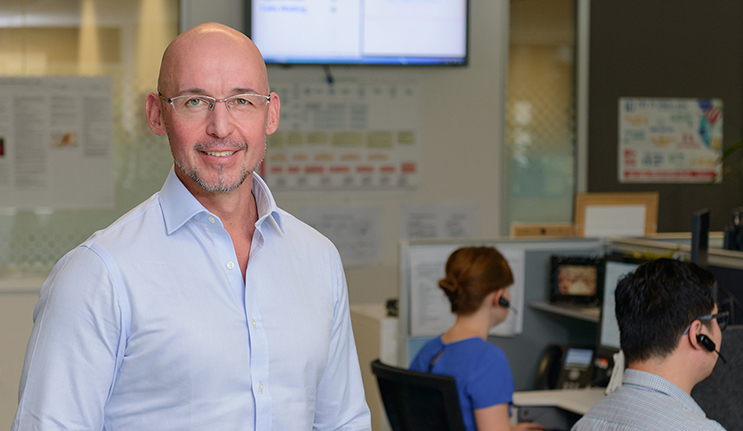
FEATURES
Forget the couch: online therapy works just as well
More than 80,000 people around Australia have accessed anxiety and depression assessment services since 2013 through Macquarie’s revolutionary digital mental health portal, the MindSpot Clinic, which is fully funded by the Australian Government Department of Health.
The clinic now also delivers interventions to help people with chronic pain manage their disability and distress.
“MindSpot prioritises services and interventions that can help the largest number of people,” says Professor Nick Titov, who is Director of MindSpot and co-Director of Macquarie’s eCentreClinic.
“Many of the people who use our service haven’t had treatment before, and many report that they’re not going to seek treatment elsewhere, for a range of reasons, including stigma and concerns about privacy.”
Professor Titov is a clinical psychologist who led the development of the innovative service and now heads up a team of more than 50 people who provide assessment and treatment for adults with anxiety, depression and chronic pain.
“People often think about going to the psychologist or psychiatrist as a deeply emotional and traumatic experience, which invariably involves recounting your deepest, darkest fears,” he says.
“But the MindSpot team have taken the approach of finding ways to help people who have anxiety and depression to manage their symptoms, without dwelling on the past.
“These symptoms are obviously incredibly distressing and disabling, but we know people can learn to manage them, and we teach people practical skills that they can use to deal with them.”
Convenience a drawcard
Many people struggle to take time off during business hours to go and visit a therapist, making the convenience and accessibility of online services a big drawcard.
“People can access our service 24/7; therapists are available until 8pm most nights, and once they’ve registered with us they can access the resources and information.”
Internet-delivered services can also complement therapies offered face-to-face, he says.
“Some of the people we work with have such severe symptoms that they aren’t able to see a professional face-to-face,” he explains.
People with severe anxiety or social phobia can find it overwhelming to leave their home. “Working with us can help them build enough confidence and skills to then be able to see somebody face-to-face for further support and treatment.”
MindSpot is a great example of stepped care. “People can use our service and then step up to more intensive face-to-face treatment; but they can also step down to our service – so, after an in-patient admission, or after working with their therapist or psychiatrist face-to-face, we can provide them with some additional support afterwards,” Nick says.
Many people come to MindSpot for assessment and information rather than treatment.
“We support people to learn practical psychological skills that can help them manage their own symptoms in the long term. We found that most of the people we work with actually just want to talk to somebody, and want to learn about their symptoms.”
Getting an assessment and information gives people agency, and the service can be accessed quickly and easily, he says – and MindSpot also helps people make informed decisions about what they can do next.
“Some people go on to treatment with us, others decide to manage their symptoms themselves, while we help others learn about and then access other services.”
In comparison, face-to-face appointments with a psychologist or a psychiatrist generally only happen after a GP referral, and the process often takes a few weeks to arrange because GPs and mental health professionals often have substantial waiting lists.
All age treatment
Despite a perception that young people are the main adopters of online solutions, the average age of MindSpot clients, surprisingly, is around 36 years – which mirrors the average age of clients who see a psychologist or a psychiatrist face-to-face.
“That’s a concern because we know the average age of onset of symptoms of anxiety and depression is in late childhood or early adulthood, so it seems people still wait for at least a decade before they seek support or treatment,” says Nick.
Around 400,000 people a year visit the MindSpot website and many complete the site’s anonymous online quizzes, which ask about symptoms of anxiety and depression and give high-level recommendations.
Each year, around 20,000 of these then choose to complete an online or a telephone-based assessment. Many go on to discuss treatment options with MindSpot staff and perhaps access their clinical services.
“The people most likely to want to talk to us during treatment by telephone calls on a weekly basis are male and likely to be older males – and that’s a group who often don’t want to engage in psychological treatment,” Nick says.
He thinks part of the reason is convenience; part of it, a sense of stigma. “Engagement rates are really high because so many of them find it easier to get help online or by phone rather than seeing someone face-to-face.”
He sees another positive product of online therapies – helping older people improve their lives.
As people age, he says, they become more resilient and confident – and often make a decision to learn to manage symptoms they have sometimes had since they were teenagers.
“Sometimes older clients will tell us, ‘I’ve had these symptoms for decades, and now I’m in my 60s or 70s or even 80s, I want to get rid of the symptoms so I can enjoy what time I have left.”
For more information and contact details: